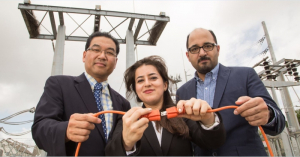Whether you’ve suffered through a major Houston hurricane, flood event or momentary glitch in the power grid, no doubt you understand the severity of a power blackout. And lest you think Houston has cornered the market on such catastrophes, think back to 2003 when the biggest blackout in U.S. history left 50 million people in darkness in the northeast corner of America stretching into Canada.
In the case of these disasters, the first question Saeedeh Abbasi thinks about is: ‘What do we have to do to restore the power quickly?’
Luckily for us, Abbasi has answers. She is a doctoral candidate studying under Professor Gino Lim, chair of the Cullen College’s department of industrial engineering and Hari and Anjali Agrawal Faculty Fellow. The pair, along with Masoud Barati, an instructional assistant professor of electrical and computer engineering, published the answers in a paper “A multi-objective MPEC model for disaster management of power system restoration,” given the Best Paper Award in the Energy Systems Division by the Institute of Industrial and Systems Engineers (IISE) during its annual conference in May 2017.
Powering back up
“We want to restore the power grid as soon as possible, so time is the most important factor in our study,” said Abbasi. “We also want to reduce the number of people impacted by a power failure.”
As an optimization expert, Abbasi breaks the population into segments, isolating those with the most critical needs like hospitals and data centers, giving them top priority in the restoration plan. Once she segments the power network into smaller sections, or micro grids, Abbasi proposes to restore power of the islanded (or independently operable) sections at the same time. This way there is less load on the lines and the power is restored quickly.
It appears to be a low key approach, even with the necessary mathematical algorithms -- called mathematical program with equilibrium constraints (the MPEC from the paper title) -- to determine assignment of demands to emergency power generators, known as black start generation units. Still, turning on one segment at a time seems such a simple solution.
“If you ask anyone about the greatest ideas, they are always the very easiest and simplest,” said Lim.
Breakthroughs
Currently in the power industry, during a failure, the black start generation units are used to restore power. These generators don’t depend on the failed electric grid to operate, but their capacity for generation is limited. Using the sectional approach, Abbasi has found a solution for their limited effectiveness.
Her solution minimizes the lost load and restoration time as well as power generation cost.
Another important innovation in the paper, said Barati, is the application of distributed energy resources in the restoration process of the power grid.
“Take, for example, the power grid on the UH campus,” said Barati. “It can be categorized as a low voltage system. The black start generation units within these systems can help the bigger power systems for the restoration process, showing the capability of the micro-generation units and micro grid in restoration of the bulk power system.”
In the end, the researchers see a better future for power restoration through the work.
“We are trying to maximize the resiliency of the restored power grid,” said Barati. With the system for restoration institutionalized, precious time can be saved in restoring power after a failure occurs.
“Resiliency is all about evolution,” said Lim. “Once you go through a process you understand the weaknesses and challenges and the process can be adapted so if the same thing happens again you will have much less damage and, in this case, quicker restoration of power.”
If anything can benefit from evolution it would be the American power grid, built in 1882 and launched by Thomas Edison at the Pearl Street Station in Manhattan. While it has expanded beyond anyone’s conception at that time, it has had few adaptations since.
“It’s a very vulnerable asset,” said Abbasi.
